An Optical Acoustic Detection System Based on Fabry Pérot Etalon Stability Structure
Abstract
:1. Introduction
2. Sensor Design and Operation Principle
3. Acoustic Measurement and Discussion
4. Conclusions
Author Contributions
Funding
Conflicts of Interest
References
- Liu, B.; Lin, J.; Wang, J.; Ye, C.; Jin, P. MEMS-based high-sensitivity Fabry–Perot acoustic sensor with a 45° angled fiber. IEEE Photonics Technol. Lett. 2016, 28, 581–584. [Google Scholar] [CrossRef]
- Zheng, H.; Lv, R.; Zhao, Y.; Wang, X.; Lin, Z.; Zhou, Y.; Zhao, Q. A novel high accuracy optical path difference compensation method based on phase difference technology. Opt. Lasers Eng. 2021, 137, 106367. [Google Scholar] [CrossRef]
- Chen, J.; Xue, C.; Zheng, Y.; Wu, L.; Chen, C.; Han, Y. Micro-fiber-optic acoustic sensor based on high-Q resonance effect using Fabry-Pérot etalon. Opt. Express 2021, 29, 16454. [Google Scholar] [CrossRef] [PubMed]
- Bing, Y.; Anbo, W.; Pickrell, G.R. Analysis of Fiber Fabry–Pérot Interferometric Sensors Using Low-Coherence Light Sources. J. Lightwave Technol. 2006, 24, 1758–1767. [Google Scholar] [CrossRef]
- Zhang, W.; Li, H.; Zhu, L.; Dong, M.; Meng, F. Dual-parameter optical fiber probe based on a three-beam fabry-perot interferometer. IEEE Sens. J. 2021, 21, 4635–4643. [Google Scholar] [CrossRef]
- Rodríguez-Quiroz, O.; Domínguez-Flores, C.E.; Monzón-Hernández, D.; Morales-Narvaez, E.; Minkovich, V.P.; López-Cortés, D. Unambiguous refractive-index measurement in a wide dynamic-range using a hybrid fiber Fabry-Perot interferometer assisted by a fiber Bragg grating. Opt. Laser Technol. 2020, 128, 106236. [Google Scholar] [CrossRef]
- Yang, X.; Wu, S.; Cheng, H.; Ma, J.; Wang, S.; Liu, S.; Lu, P. Simplified highly-sensitive gas pressure sensor based on harmonic Vernier effect. Opt. Laser Technol. 2021, 140, 107007. [Google Scholar] [CrossRef]
- Chen, D.; Qian, J.; Liu, J.; Chen, B.; An, G.; Hong, Y.; Jia, P.; Xiong, J. An in-line Fiber optic fabry–Perot sensor for high-temperature vibration measurement. Micromachines 2020, 11, 252. [Google Scholar] [CrossRef] [PubMed] [Green Version]
- Zhang, W.; Lu, P.; Ni, W.; Xiong, W.; Liu, D.; Zhang, J. Gold-diaphragm based Fabry-Perot ultrasonic sensor for partial discharge detection and localization. IEEE Photonics J. 2020, 12, 1–12. [Google Scholar] [CrossRef]
- Yang, S.; Feng, Z.; Jia, X.; Pickrell, G.; Ng, W.; Wang, A.; Zhu, Y. All-sapphire miniature optical fiber tip sensor for high temperature measurement. J. Lightwave Technol. 2020, 38, 1988–1997. [Google Scholar] [CrossRef]
- Wang, S.; Lu, P.; Liu, L.; Liao, H.; Sun, Y.; Ni, W.; Fu, X.; Jiang, X.; Liu, D.; Zhang, J.; et al. An infrasound sensor based on extrinsic fiber-optic Fabry–Perot interferometer structure. IEEE Photonics Technol. Lett. 2016, 28, 1264–1267. [Google Scholar] [CrossRef]
- Wang, Q.; Yu, Q. Polymer diaphragm based sensitive fiber optic Fabry-Perot acoustic sensor. Chin. Opt. Lett. 2010, 8, 266–269. [Google Scholar] [CrossRef]
- Ni, W.; Lu, P.; Fu, X.; Zhang, W.; Shum, P.P.; Sun, H.; Yang, C.; Liu, D.; Zhang, J. Ultrathin graphene diaphragm-based extrinsic Fabry-Perot interferometer for ultra-wideband fiber optic acoustic sensing. Opt. Express 2018, 26, 20758–20767. [Google Scholar] [CrossRef]
- Zhang, W.; Lu, P.; Qu, Z.; Fan, P.; Sima, C.; Liu, D.; Zhang, J. High sensitivity and high stability dual Fabry-Perot interferometric fiber-optic acoustic sensor based on sandwich-structure composite diaphragm. IEEE Photonics J. 2021, 13, 7100113. [Google Scholar] [CrossRef]
- Lyu, D.; Peng, J.; Huang, Q.; Zheng, W.; Xiong, L.; Yang, M. Radiation-resistant optical fiber Fabry-Perot interferometer used for high-temperature sensing. IEEE Sens. J. 2021, 21, 57–61. [Google Scholar] [CrossRef]
- Fischer, B. Optical microphone hears ultrasound. Nat. Photonics 2016, 10, 356–358. [Google Scholar] [CrossRef]
- Fischer, B.; Sarasini, F.; Tirillò, J.; Touchard, F.; Chocinski-Arnault, L.; Mellier, D.; Panzer, N.; Sommerhuber, R.; Russo, P.; Papa, I.; et al. Impact damage assessment in biocomposites by micro-CT and innovative air-coupled detection of laser-generated ultrasound. Compos. Struct. 2019, 210, 922–931. [Google Scholar] [CrossRef]
- Preisser, S.; Rohringer, W.; Liu, M.; Kollmann, C.; Zotter, S.; Fischer, B.; Drexler, W. All-optical highly sensitive akinetic sensor for ultrasound detection and photoacoustic imaging. Biomed. Opt. Express 2016, 7, 4171–4186. [Google Scholar] [CrossRef] [PubMed] [Green Version]
- Chen, M.; Xie, S.; Zhou, G.; Wei, D.; Wu, H.; Takahashi, S.; Matsumoto, H.; Takamasu, K. Absolute distance measurement based on spectral interferometer using the effect of the FSR of a Fabry–Perot etalon. Opt. Lasers Eng. 2019, 123, 20–27. [Google Scholar] [CrossRef]
- Zhu, S.; Yongrui, G.; Minzhi, X.; Huadong, L. The design and realization of high fineness passive optical resonator and its application in lasers’ frequency stability. J. Quantum Opt. 2018, 24, 237–242. [Google Scholar]
- 2051-2053-User-Manual-RevB. Available online: https://www.newport.com.cn/p/2053-FS-M (accessed on 9 December 2021).
- Ciddor, P.E. Refractive index of air: 3. The roles of CO2, H2O, and refractivity virials. Appl. Opt. 2002, 41, 2292–2298. [Google Scholar] [CrossRef]
- Rüeger, J.M. Refractive indices of light, infrared and radio waves in the atmosphere. Report of the Ad-Hoc working party of the IAG special commission SC3 on fundamental parameters (SCFC), 1999–2003. In Proceedings of the 23rd General Assembly of IUGG, Sapporo, Japan, 30 June–11 July 2003. [Google Scholar]
- Dass, S.; Chatterjee, K.; Kachhap, S.; Jha, R. In reflection metal coated diaphragm microphone using PCF modal interferometer. J. Lightwave Technol. 2021, 39, 3974–3980. [Google Scholar] [CrossRef]
- Chen, J.; Zheng, Y.; Xue, C.; Zhang, C.; Chen, Y. Filtering effect of SiO2 optical waveguide ring resonator applied to optoelectronic oscillator. Opt. Express 2018, 26, 12638–12647. [Google Scholar] [CrossRef]
- Hu, H.; Chou, H.; Lee, T. Robust blind speech watermarking via fft-based perceptual vector norm modulation with frame self-synchronization. IEEE Access 2021, 9, 9916–9925. [Google Scholar] [CrossRef]
- TYPE 4189 Free-Field Microphone. Available online: https://www.bksv.com/en/transducers/acoustic/microphones/microphone-cartridges/4189 (accessed on 1 December 2021).
- Eta100 Ultra Optical Microphone. Available online: https://xarion.com/en/products/eta100-ultra (accessed on 1 December 2021).
- Liu, L.; Lu, P.; Wang, S.; Fu, X.; Sun, Y.; Liu, D.; Zhang, J.; Xu, H.; Yao, Q. UV Adhesive diaphragm-based FPI sensor for very-low-frequency acoustic sensing. IEEE Photonics J. 2016, 8, 1–9. [Google Scholar] [CrossRef]
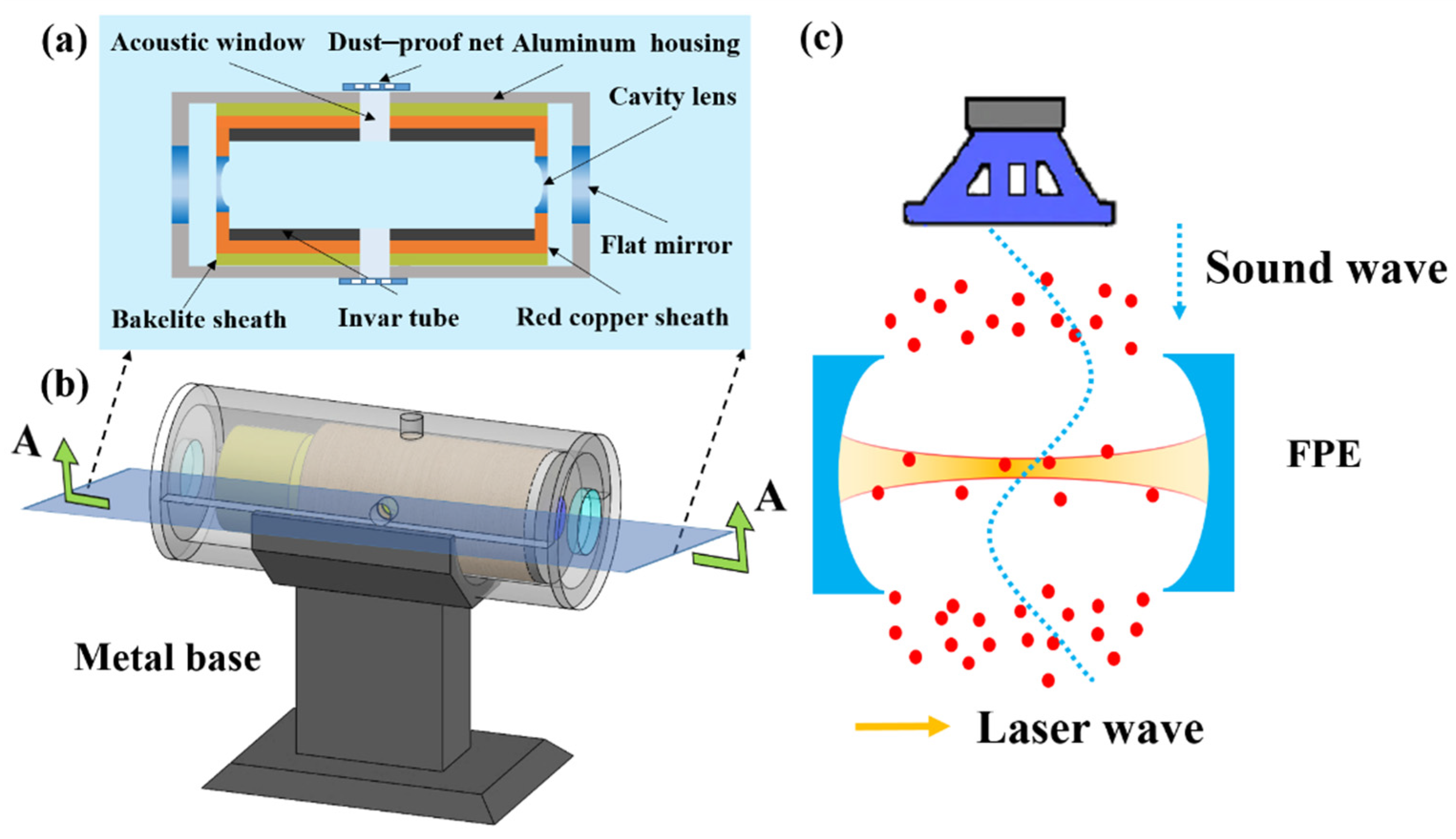
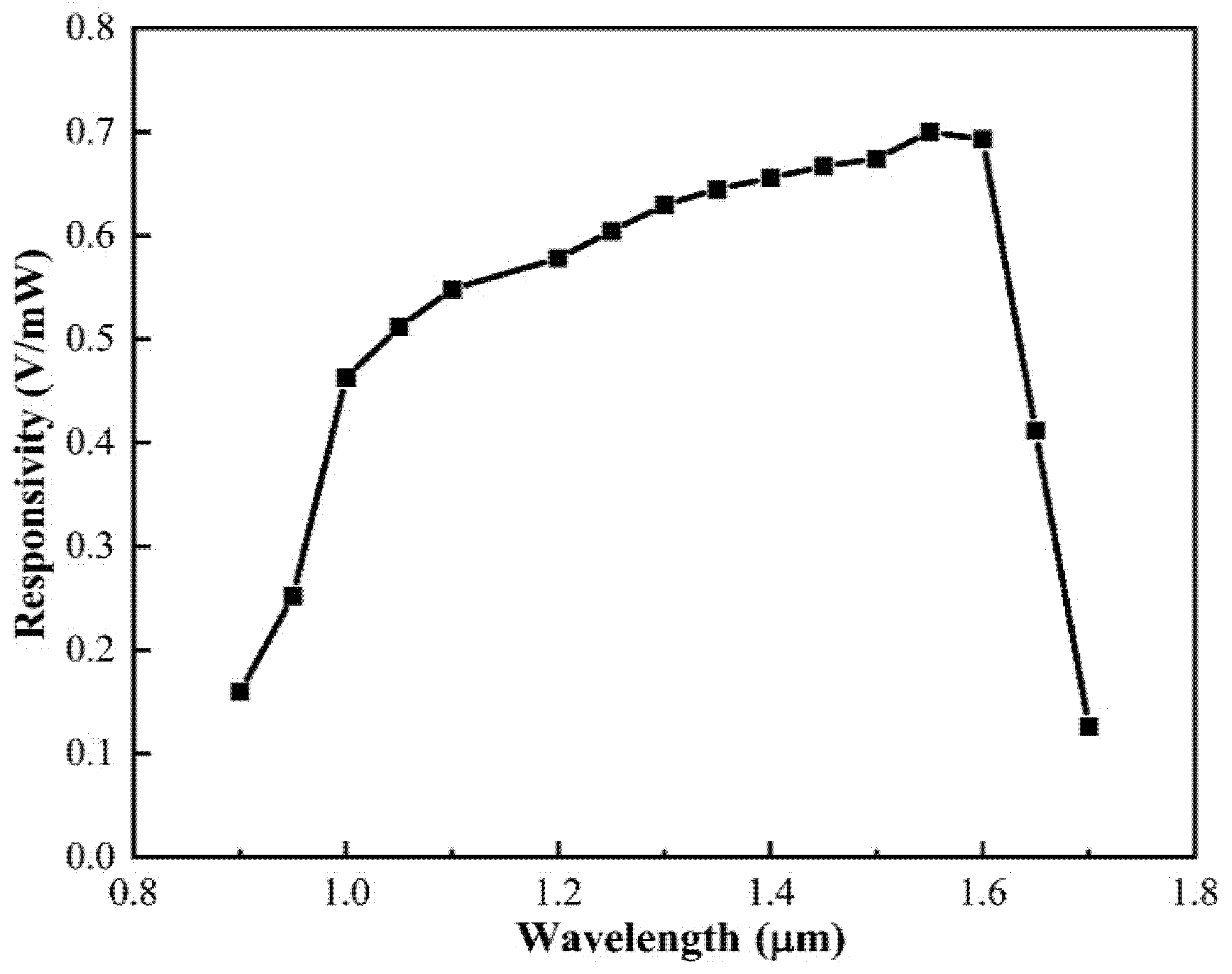

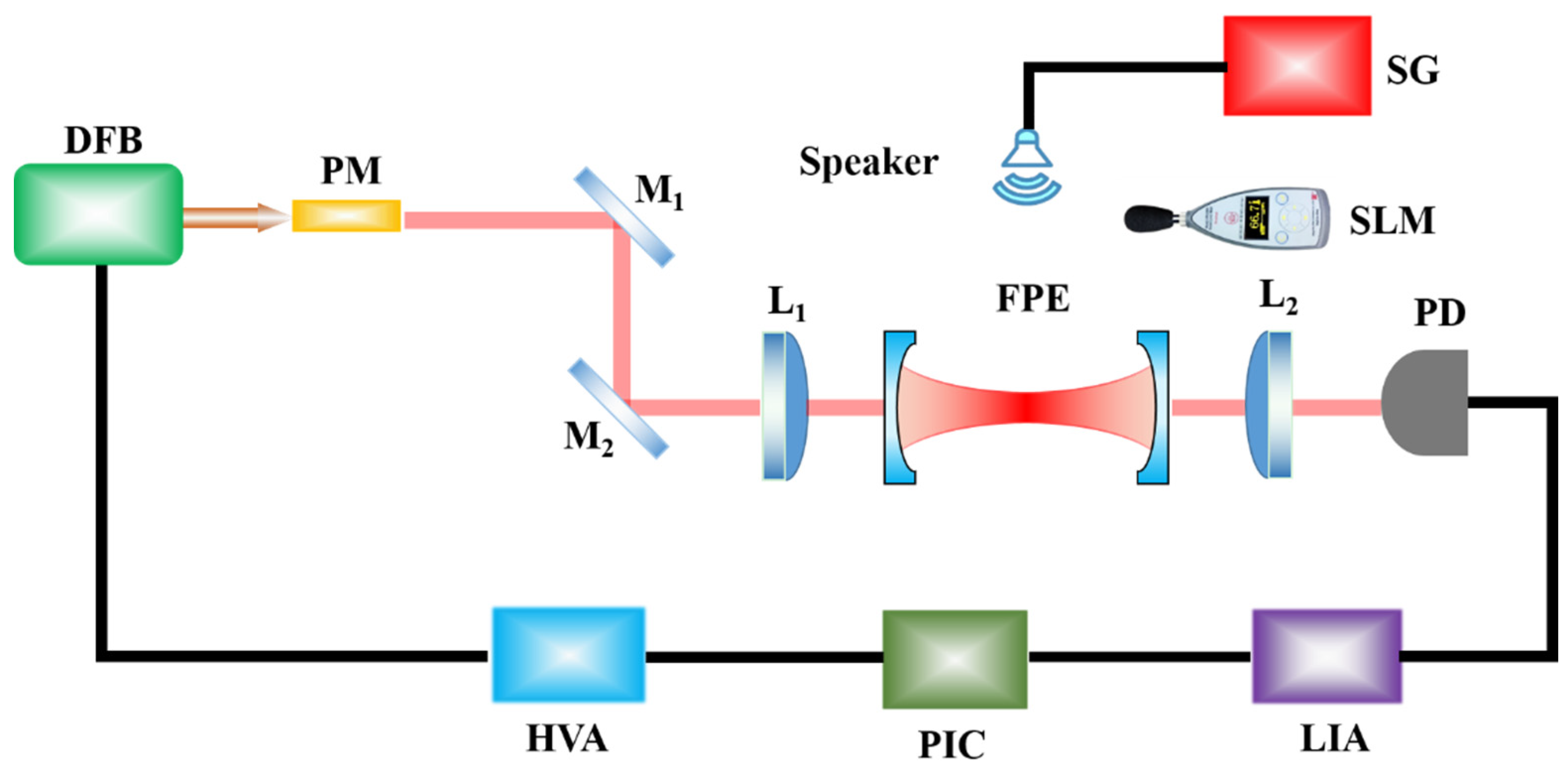


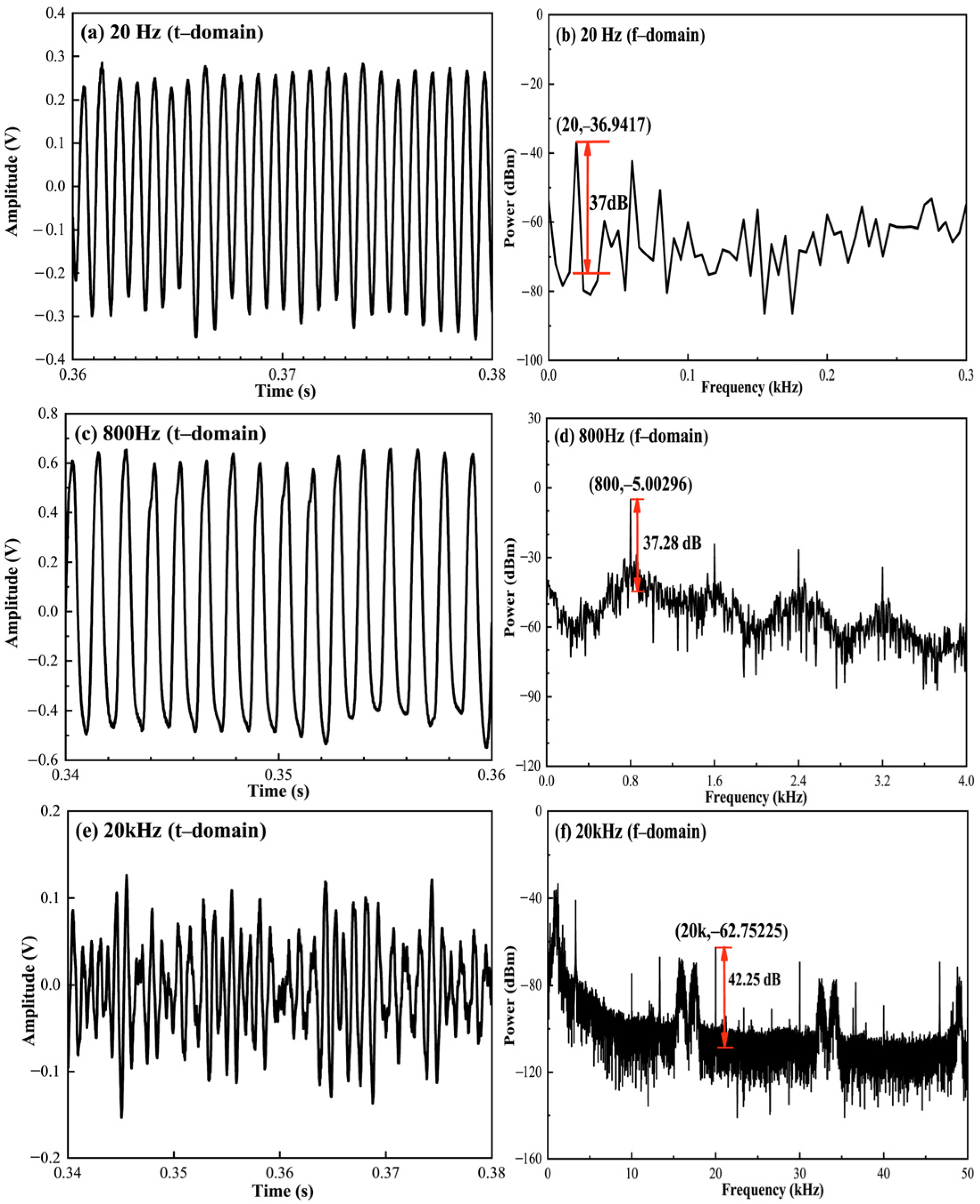
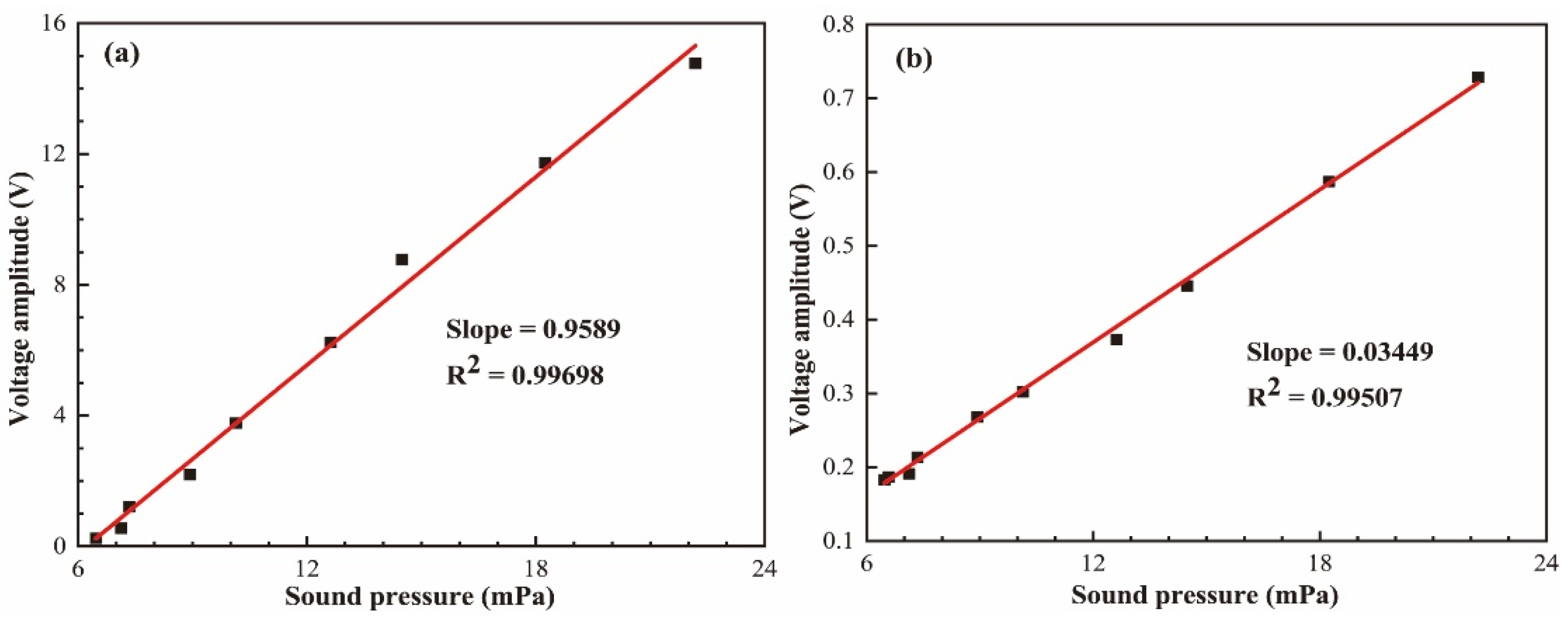
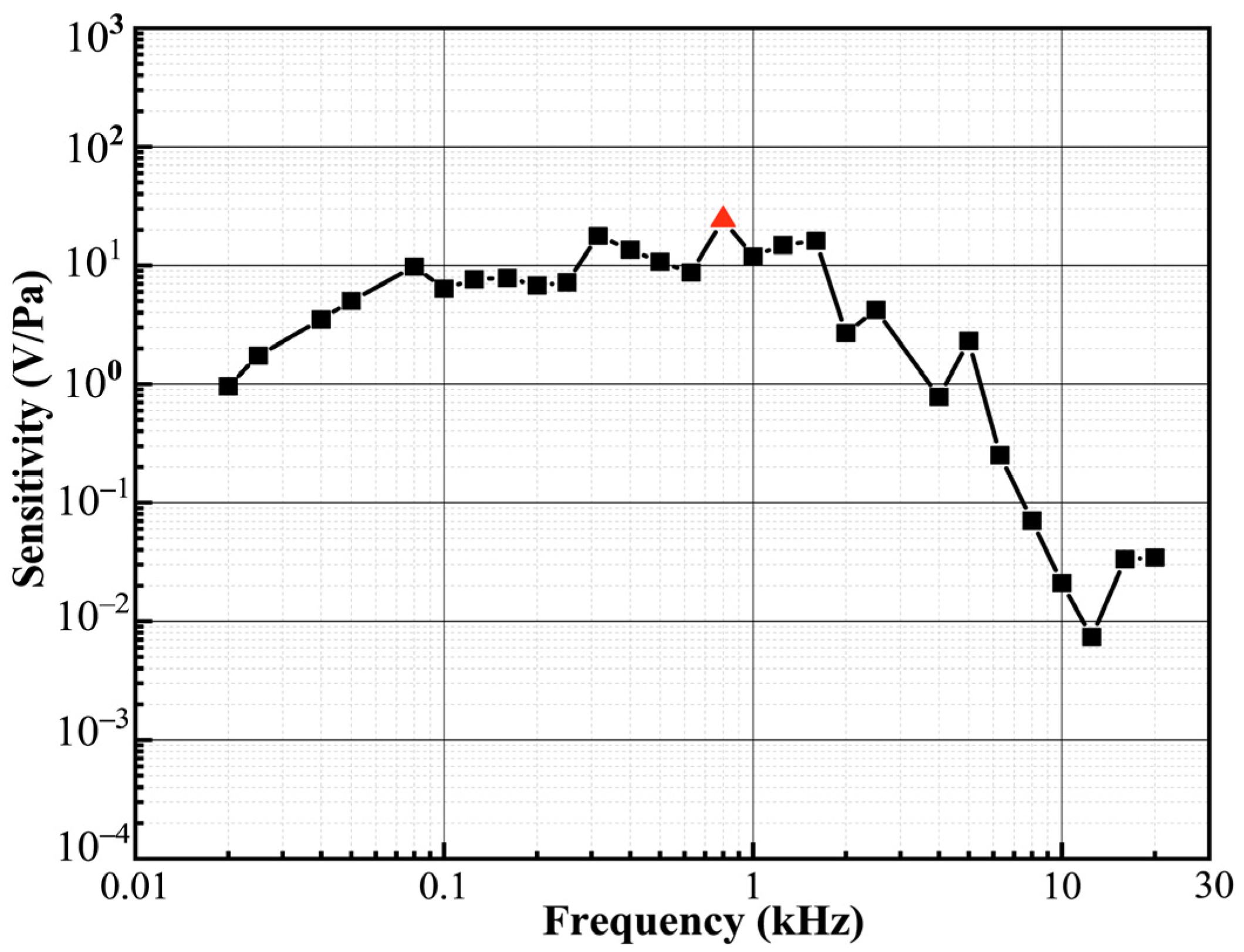
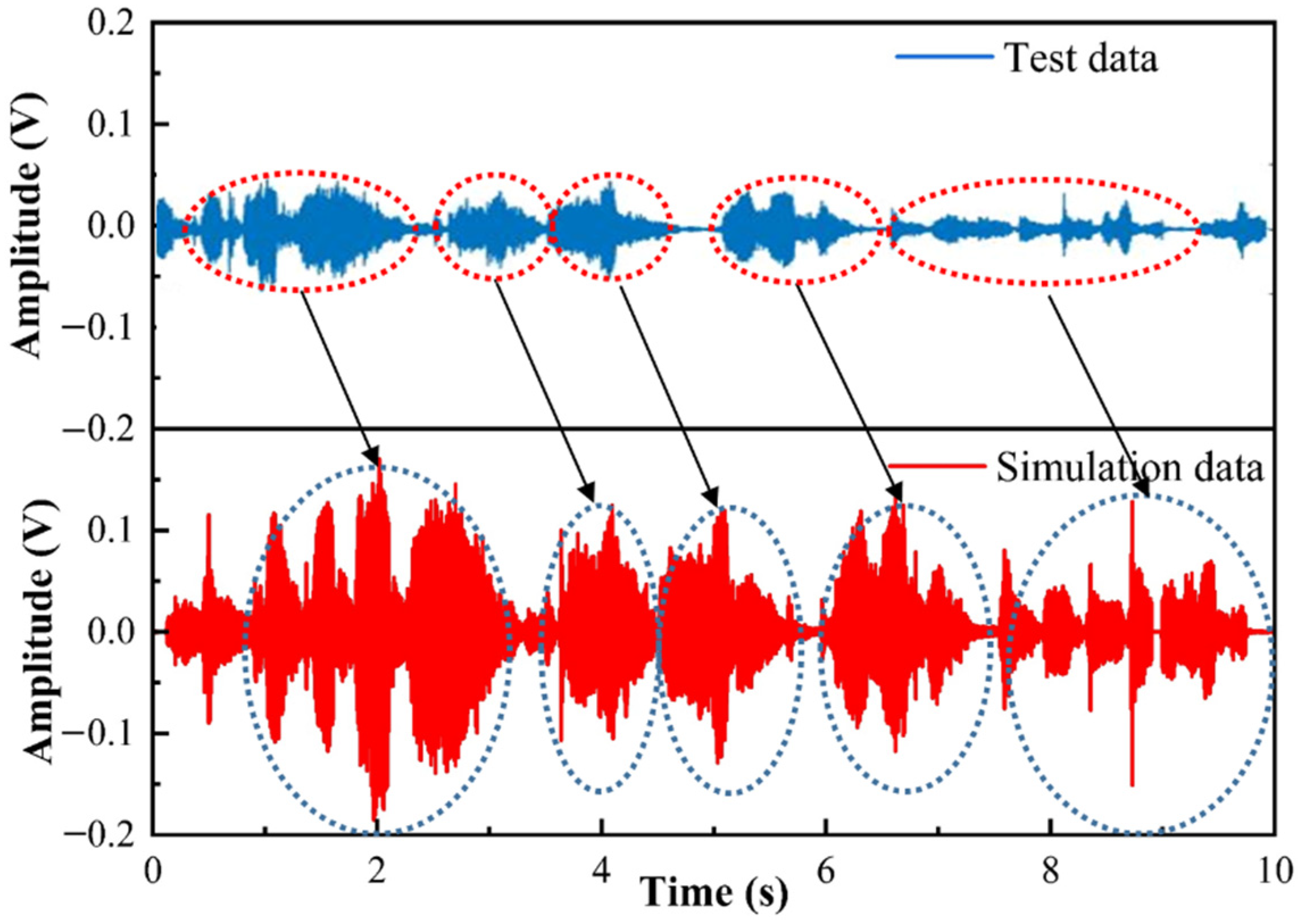
| Type | Testing Principle | Sensitivity (mV/Pa) | SNR (dB) | Frequency Response Range (Hz) | Size (mm × mm) | Ref. |
|---|---|---|---|---|---|---|
| B&K 4189 | Changes in capacitance | 50 | 6.3–20 k | 12.7 × 11.7 | [27] | |
| Xarion Eta 100 Ultra | Changes in refractive index | 0.35 | 52 | 10–1 M | 5 × 33 | [28] |
| FPI | Vibration of thin membrane | 57.3 | 30 | 1–20 k | 2.5 × 9 | [29] |
| Proposed | Changes in refractive index | 958.9 | 42.25 | 20–20 k 1 | 80 × 100 |
Publisher’s Note: MDPI stays neutral with regard to jurisdictional claims in published maps and institutional affiliations. |
© 2021 by the authors. Licensee MDPI, Basel, Switzerland. This article is an open access article distributed under the terms and conditions of the Creative Commons Attribution (CC BY) license (https://creativecommons.org/licenses/by/4.0/).
Share and Cite
Wu, L.; Zheng, Y.; Xue, C.; Bai, J.; Chen, J. An Optical Acoustic Detection System Based on Fabry Pérot Etalon Stability Structure. Micromachines 2021, 12, 1564. https://doi.org/10.3390/mi12121564
Wu L, Zheng Y, Xue C, Bai J, Chen J. An Optical Acoustic Detection System Based on Fabry Pérot Etalon Stability Structure. Micromachines. 2021; 12(12):1564. https://doi.org/10.3390/mi12121564
Chicago/Turabian StyleWu, Liyun, Yongqiu Zheng, Chenyang Xue, Jiandong Bai, and Jiamin Chen. 2021. "An Optical Acoustic Detection System Based on Fabry Pérot Etalon Stability Structure" Micromachines 12, no. 12: 1564. https://doi.org/10.3390/mi12121564





